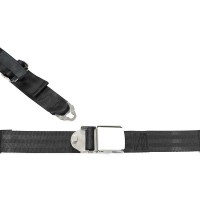1-877-795-2278 | info@aircraftspruce.ca
Aircraft Spruce Canada
Brantford, ON Canada
Corona, CA | Peachtree City, GA
Chicago, IL | Wasilla, AK
Aircraft Spruce Canada
Brantford, ON Canada
Corona, CA | Peachtree City, GA
Chicago, IL | Wasilla, AK
FREE SHIPPING ON ORDERS OVER $699 (SOME EXCLUSIONS APPLY) | 877-795-2278
C-47 Skytrain
$495.00/Each
Part# 13-10494
MFR Model# AC047BBSS
MFR Model# AC047BBSS
Overview
|
In 1936, Douglas DCs military career began in 1936 when the Army Air Corps ordered a pair of DC-2s and then a contract followed for 18 more DC-2s. By 1941, the time when the Army Corps became transformed as the Army Air Forces, they selected the C-47 Skytrain, a modified version of the DC-3, to become their standard transport aircraft. The C-47 Skytrains major modifications include a reinforced fuselage door and an additional large cargo door. Other modifications include the fitting of cargo hooks beneath the center wing section and the removal of the tail cone to mount a hook for towing gliders. The C-47 could carry up to 6,000 cargo. It could also hold a fully assembled jeep. As a transport troop, it could carry 28 soldiers in full combat gear. AS a medical gear, it could accommodate 14 stretcher patients and three nurses. Over 10,000 aircraft were produced in Long Beach and Santa Monica, California and Oklahoma City. Basic versions were built and the aircraft was given 22 designations (AC-47D gunship the EC-47, the EC-47Q and the C-53 Skytrooper.) The Royal Canadian Air Force also adopted the use of C-47 for search and rescue operations throughout the 1940s and 50s. The C-47 remained in service long after World War II and played a critical role in the initial stages of the Berlin Airlift and saw action in the Korean and Vietnam wars. The C-47 was subsequently replaced by the C-54. |
Q&A
Please note, Aircraft Spruce Canada's personnel are not certified aircraft mechanics and can only provide general support and ideas, which should not be relied upon or implemented in lieu of consulting an A&P or other qualified technician. Aircraft Spruce Canada assumes no responsibility or liability for any issue or problem which may arise from any repair, modification or other work done from this knowledge base. Any product eligibility information provided here is based on general application guides and we recommend always referring to your specific aircraft parts manual, the parts manufacturer or consulting with a qualified mechanic.

 Aircraft Spruce Canada
Aircraft Spruce Canada






